 W
WThe Crown Jewels of the United Kingdom, originally the Crown Jewels of England, are a collection of royal ceremonial objects kept in the Tower of London, which include the regalia and vestments worn by British kings and queens at their coronations.
 W
WThe Black Prince's Ruby is a large, irregular cabochon red spinel weighing 170 carats (34 g) set in the cross pattée above the Cullinan II diamond at the front of the Imperial State Crown of the United Kingdom. The spinel is one of the oldest parts of the Crown Jewels of the United Kingdom, with a history dating back to the middle of the 14th century. It has been in the possession of England's rulers since it was given in 1367 to its namesake, Edward of Woodstock. The stone is believed to have originated from the Badakhshan mines in present day Afghanistan and Tajikistan, the principal source of large spinel gems in the middle ages.
 W
WThe Coronation Crown of George IV is an elaborate coronation crown made specially for George IV, King of the United Kingdom, in 1821.
 W
WThe Crown of Queen Adelaide was the consort crown of the British queen Adelaide of Saxe-Meiningen. It was used at Adelaide's coronation in 1831. It was emptied of its jewels soon afterwards, and has never been worn since.
 W
WThe Crown of Queen Alexandra was the consort crown of the British queen Alexandra of Denmark. It was manufactured for the 1902 coronation of King Edward VII and Queen Alexandra.
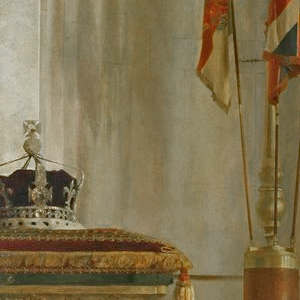 W
WThe Crown of Queen Elizabeth The Queen Mother, also known as The Queen Mother's Crown, is the crown made for Queen Elizabeth, the wife of King George VI, to wear at their coronation in 1937 and State Openings of Parliament during her husband's reign. The crown was made by Garrard & Co., the Crown Jeweller at the time, and is modelled partly on the design of the Crown of Queen Mary, though it differs by having four half-arches instead of eight. As with Queen Mary's Crown, its arches are detachable at the crosses pattée, allowing it to be worn as a circlet or open crown. It is the only crown for a British king or queen to be made of platinum.
 W
WThe Crown of Queen Mary is the consort crown made for Mary of Teck in 1911.
 W
WThe Cullinan Diamond is the largest gem-quality rough diamond ever found, weighing 3,106.75 carats (621.35 g), discovered at the Premier No.2 mine in Cullinan, South Africa, on 26 January 1905. It was named after Thomas Cullinan, the mine's chairman. In April 1905, it was put on sale in London, but despite considerable interest, it was still unsold after two years. In 1907, the Transvaal Colony government bought the Cullinan and Prime Minister Louis Botha presented it to Edward VII, King of the United Kingdom, who had it cut by Joseph Asscher & Co. in Amsterdam.
 W
WThe Great 'H' of Scotland was a jewel belonging to Mary, Queen of Scots. It was broken up in 1604 and made into the Mirror of Great Britain for James VI and I.
 W
WThe Imperial Crown of India is the crown that was used by King George V in his capacity as Emperor of India at the Delhi Durbar of 1911.
 W
WThe Imperial State Crown is one of the Crown Jewels of the United Kingdom and symbolises the sovereignty of the monarch.
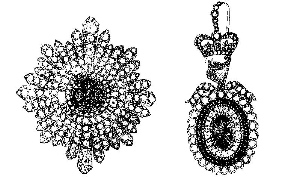 W
WThe Jewels Belonging to the Most Illustrious Order of Saint Patrick, commonly called the Irish Crown Jewels or State Jewels of Ireland, were the heavily jewelled star and badge regalia created in 1831 for the Sovereign and Grand Master of the Order of St. Patrick, an order of knighthood established in 1783 by George III as King of Ireland to be an Irish equivalent of the English Order of the Garter and the Scottish Order of the Thistle. The British monarch was the Sovereign of the order, as monarch of Ireland until 1801 and of the United Kingdom of Great Britain and Ireland thereafter. The Lord Lieutenant of Ireland was the Grand Master in the absence of the Sovereign. The insignia were worn by the Sovereign at the investiture of new Knights as members of the order, and by the Grand Master on other formal ceremonial occasions. They were stolen from Dublin Castle in 1907 along with the collars of five knights of the order. The theft has never been solved and the jewels have never been recovered.
 W
WThe Jewel House is a vault housing the British Crown Jewels in the Waterloo Block at the Tower of London. It was opened by Queen Elizabeth II in 1994 and refurbished in 2012. Regalia have been kept in various parts of the Tower since the 14th century after a series of successful and attempted thefts at Westminster Abbey.
 W
WAn inventory of the jewels of Mary I of England, as Princess Mary in the years 1542 to 1546 was kept by her lady in waiting Mary Finch. The manuscript is now held by the British Library. It was published by Frederic Madden in 1831. Some pieces are listed twice. Hans Holbein the Younger designed jewels for her. Two surviving drawings feature a ribbon with the inscription, "MI LADI PRINSIS".
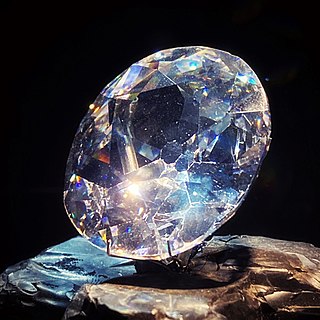 W
WThe Koh-i-Noor, also spelt Kohinoor and Koh-i-Nur, is one of the largest cut diamonds in the world, weighing 105.6 carats (21.12 g). It is part of the British Crown Jewels.
 W
WThe Lily Font is a large silver-gilt baptismal font used at the baptismal services of members of the British Royal Family. It is part of the Royal Collection and is kept at the Jewel House at the Tower of London when not in use. The Lily Font has been used for the baptism of all the children and grandchildren of Queen Elizabeth II except that of Princess Eugenie of York.
 W
WThe Mary Tudor pearl or simply The Tudor pearl is an asymmetrical drop-shaped pearl featured in at least three portraits of Queen Mary I of England and estimated to be 64.5 carats, 258 grams in weight and dated to 1526. It is often mistakenly depicted as the La Peregrina pearl, however, Mary Tudor could never have worn the Peregrina as it was first recorded in 1579, 21 years after her death.
 W
WThe Mirror of Great Britain was a piece of jewellery that was part of the Crown Jewels of the United Kingdom during the reign of King James VI and I. It was pawned in 1625 and is considered lost.
 W
WThe Small Diamond Crown of Queen Victoria is a miniature imperial and state crown made at the request of Queen Victoria in 1870 to wear over her widow's cap following the death of her husband, Prince Albert. It was perhaps the crown most associated with the queen and is one of the Crown Jewels on public display in the Jewel House at the Tower of London.
 W
WSt Edward's Crown is the centrepiece of the Crown Jewels of the United Kingdom. Named after Saint Edward the Confessor, it has been traditionally used to crown English and British monarchs at their coronations since the 13th century.
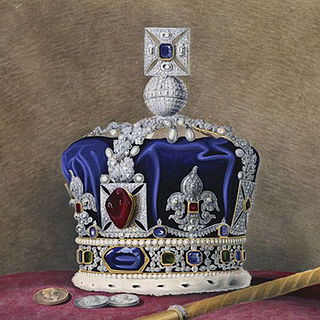 W
WSt Edward's Sapphire is an octagonal, rose-cut sapphire that forms part of the British Crown Jewels.
 W
WThe State Crown of George I is the imperial and state crown manufactured in 1714 for King George I. It was modified and used by subsequent monarchs until 1838. The empty gold frame and its aquamarine monde which dates from the reign of King James II are both part of the Crown Jewels of the United Kingdom. They are on public display in the Martin Tower at the Tower of London.
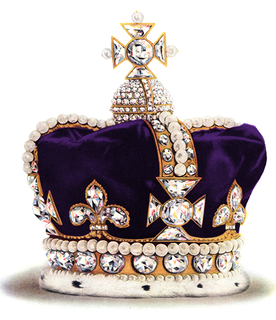 W
WThe State Crown of Mary of Modena is the consort crown made in 1685 for Mary of Modena, queen of England, Scotland and Ireland. It was used by future queens consort up until the end of the 18th century.
 W
WThe Stuart Sapphire is a blue sapphire that forms part of the British Crown Jewels. It weighs 104 carat and is believed to have originated from Asia, potentially present day Afghanistan, Sri Lanka, Myanmar or Kashmir.
 W
WThe Three Brothers was a piece of jewellery created in the late 14th century, which consisted of three rectangular red spinels arranged around a central diamond. The jewel is known for having been owned by a number of important historical figures. After its commission by Duke John the Fearless of Burgundy, the jewel was part of the Burgundian crown jewels for almost 100 years, before passing into the possession of German banker Jakob Fugger.
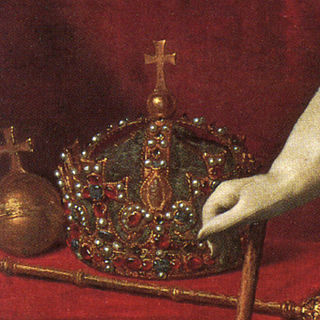 W
WThe Tudor Crown, also known as Henry VIII's Crown, was the imperial and state crown used by the monarchs of England and Great Britain from around the time of Henry VIII up to the English Civil War in 1649. It was described by the art historian Sir Roy Strong as "a masterpiece of early Tudor jeweller's art", and its form has been compared to the crown of the Holy Roman Empire.